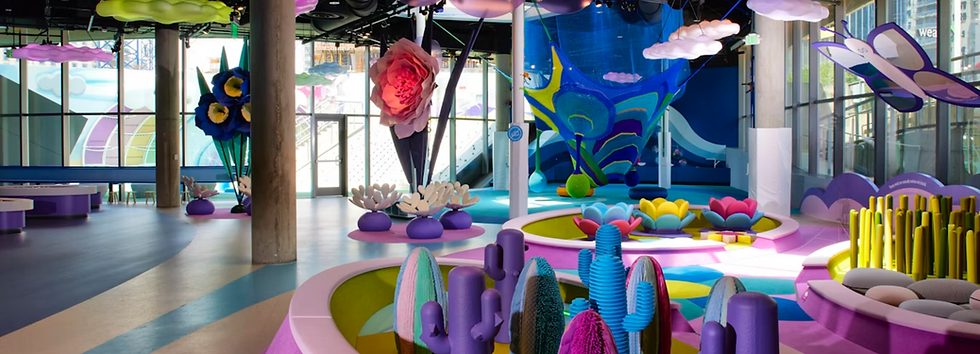Child Development: Why Ninja Warrior Is an Excellent Start for 1-Year-Olds
- AqilFitness
- Jul 25
- 3 min read

Is your toddler already climbing furniture, crawling under tables, and balancing on cushions? Believe it or not, those are the first steps to becoming a mini Ninja Warrior. And science says you should encourage it.
Ninja Warrior-style movement activities aren't just fun - they’re foundational for early child development, even as early as age 12 to 24 months. Here's why getting your 1-year-old started on basic ninja-inspired activities can set the stage for stronger brains, better bodies, and a lifetime love of movement.
Why Movement Matters at Age 1
At age 1, children are hitting critical developmental milestones - physically, cognitively, and emotionally. According to the Centers for Disease Control and Prevention (CDC), toddlers at this age are beginning to:
Stand and walk independently
Explore objects by touching, banging, throwing
Start problem-solving with simple actions (like stacking blocks)
Motor play is how they learn about the world.
In fact, research from the American Academy of Pediatrics (AAP) states that “physical activity in early childhood is essential for developing motor skills, bone strength, coordination, and mental health.” It also helps build executive function—things like memory, attention span, and impulse control.
What Can a 1-Year-Old Do in a Ninja Warrior Class?
You don’t need warped walls or salmon ladders to get your toddler started. Here are age-appropriate ninja-style activities that support gross motor skill development while keeping it fun and safe:
✅ Crawling Tunnels
What it builds: Core strength, spatial awareness
Ninja tip: Set up a play tunnel or create a homemade version with pillows and blankets. Encourage your little one to crawl through to you!
✅ Balance Beams (Low and Wide)
What it builds: Balance, coordination, confidence
Ninja tip: Use a foam balance beam or even a strip of painter’s tape on the floor. Let them walk holding your hands.
✅ Step-and-Climb Obstacles
What it builds: Leg strength, climbing confidence
Ninja tip: Soft foam blocks, stairs with supervision, or climbable gym equipment are perfect for this stage.
✅ Gripping and Hanging
What it builds: Grip strength, arm development
Ninja tip: Use a toddler-safe bar or even a low monkey bar setup. Let them hang for a second or two while supported.
✅ Jumping Mats
What it builds: Leg power, stability
Ninja tip: Thick foam mats or mini trampolines (with side supports) help them explore safe bouncing and landings.
Scientific Backing: The Neuroscience of Ninja Play
Studies have shown that movement stimulates brain development, especially in the early years. According to a 2021 study in Frontiers in Psychology, physical activity directly influences cognitive development by enhancing synaptic plasticity and supporting memory and learning functions.
Additionally, research from the National Institutes of Health (NIH) links early physical activity to:
Improved emotional regulation
Increased language acquisition
Reduced behavioral issues later in life
When your 1-year-old is navigating a soft climbing ramp or balancing with your help, they’re doing more than just having fun - they’re literally building their brain.
Social and Emotional Development Through Movement
Ninja-style play also fosters independence, resilience, and social interaction. In a group setting (like a toddler ninja class), children start to:
Observe and imitate peers
Learn turn-taking and patience
Build confidence by overcoming challenges
This lines up with Erik Erikson’s psychosocial theory, which identifies early toddlerhood as the “Autonomy vs. Shame and Doubt” stage - where kids learn confidence through safe exploration.
How to Get Started: Tips for Parents
Here’s how you can safely introduce your toddler to ninja-style activities at home or in a gym setting:
Start with Low-to-Ground, Padded Setups
Use foam blocks, soft mats, or soft balls to create climbing and crawling spaces.
Supervise Without Over-Assisting
Let them try! Catch them if needed but allow trial and error for self-discovery.
Celebrate Small Wins
Clapping when they crawl through a tunnel or balance for two seconds reinforces effort.
Take Ninja Warrior Toddler Lessons with AqilFitness
These lessons are not only fun, but strategic. They're conducted in accordance to a lesson plan, but modified as needed based on the toddler.
Final Thoughts
Ninja Warrior might look like a sport for older kids and adults - but it actually starts with the most foundational movements of early childhood. At age 1, your child is already wired to climb, balance, grip, and explore. A ninja-inspired environment simply gives that curiosity a safe and structured outlet.
By encouraging early movement, you’re not just building a future athlete - you’re supporting healthy brain development, emotional growth, and a love of physical activity that could last a lifetime.
Looking for a Ninja Warrior Lesson for your Toddler?
Join us at AqilFitness! We offer parent-assisted ninja lessons designed specifically for ages 1–3. With a focus on fun, safety, and developmental support, your little one will be learning while having a blast.






Comments